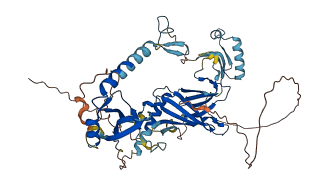Q5BDB9
Gene name |
yos9 (AN1461) |
Protein name |
Protein OS-9 homolog |
Names |
|
Species |
Emericella nidulans (strain FGSC A4 / ATCC 38163 / CBS 112.46 / NRRL 194 / M139) (Aspergillus nidulans) |
KEGG Pathway |
ani:AN1461.2 |
EC number |
|
Protein Class |
|

Descriptions
The autoinhibited protein was predicted that may have potential autoinhibitory elements via cis-regPred.
Autoinhibitory domains (AIDs)
Target domain |
|
Relief mechanism |
|
Assay |
cis-regPred |
Accessory elements
No accessory elements
Autoinhibited structure

Activated structure

1 structures for Q5BDB9
| Entry ID | Method | Resolution | Chain | Position | Source |
|---|---|---|---|---|---|
| AF-Q5BDB9-F1 | Predicted | AlphaFoldDB |
No variants for Q5BDB9
| Variant ID(s) | Position | Change | Description | Diseaes Association | Provenance |
|---|---|---|---|---|---|
| No variants for Q5BDB9 | |||||
No associated diseases with Q5BDB9
2 GO annotations of cellular component
| Name | Definition |
|---|---|
| endoplasmic reticulum lumen | The volume enclosed by the membranes of the endoplasmic reticulum. |
| endoplasmic reticulum membrane | The lipid bilayer surrounding the endoplasmic reticulum. |
1 GO annotations of molecular function
| Name | Definition |
|---|---|
| carbohydrate binding | Binding to a carbohydrate, which includes monosaccharides, oligosaccharides and polysaccharides as well as substances derived from monosaccharides by reduction of the carbonyl group (alditols), by oxidation of one or more hydroxy groups to afford the corresponding aldehydes, ketones, or carboxylic acids, or by replacement of one or more hydroxy group(s) by a hydrogen atom. Cyclitols are generally not regarded as carbohydrates. |
3 GO annotations of biological process
| Name | Definition |
|---|---|
| endoplasmic reticulum unfolded protein response | The series of molecular signals generated as a consequence of the presence of unfolded proteins in the endoplasmic reticulum (ER) or other ER-related stress; results in changes in the regulation of transcription and translation. |
| retrograde protein transport, ER to cytosol | The directed movement of unfolded or misfolded proteins from the endoplasmic reticulum to the cytosol through the translocon. |
| ubiquitin-dependent ERAD pathway | The series of steps necessary to target endoplasmic reticulum (ER)-resident proteins for degradation by the cytoplasmic proteasome. Begins with recognition of the ER-resident protein, includes retrotranslocation (dislocation) of the protein from the ER to the cytosol, protein ubiquitination necessary for correct substrate transfer, transport of the protein to the proteasome, and ends with degradation of the protein by the cytoplasmic proteasome. |
No homologous proteins in AiPD
| UniProt AC | Gene Name | Protein Name | Species | Evidence Code |
|---|---|---|---|---|
| No homologous proteins | ||||
| 10 | 20 | 30 | 40 | 50 | 60 |
| MRRQSRIVAS | LLVLACASSG | AFAHRKFNVH | DDLLAYPQFR | IKFPDGFILE | SQARAFLEQA |
| 70 | 80 | 90 | 100 | 110 | 120 |
| PYSSPDLNDI | SEQTPLKDES | EESIRDGSSG | EKAKFSYEEL | SLEGQRYLCQ | IPVVEDGDSN |
| 130 | 140 | 150 | 160 | 170 | 180 |
| RTKVEVNEEE | ERKELARATD | RGLELLREME | GKCLYYISGW | WSYSFCYMNQ | IKQFHALPSG |
| 190 | 200 | 210 | 220 | 230 | 240 |
| GGVPNYPPME | DHTTHSFILG | RFPQEEGQDE | GKGAKSGKSS | TELAELQTKG | GSRYLVQRLE |
| 250 | 260 | 270 | 280 | 290 | 300 |
| SGDQCDLTGK | NRKIEVQFHC | NPQSTDRIAW | IKELYTCSYL | MLIYTPRLCN | DVAFLPPQQE |
| 310 | 320 | 330 | 340 | 350 | 360 |
| EVHTIECREI | LTPEEVTGWQ | AMHEYQLSQQ | LVESAEAPKH | QVIGGIEVGA | QRLVGTEGKR |
| 370 | 380 | 390 | 400 | 410 | 420 |
| IEKGRVASIG | EEKVDVVAKR | VNGEVQLLSA | EELKKFDLDE | AKIEELRKKL | EEWAKGKDWT |
| 430 | 440 | 450 | 460 | 470 | 480 |
| LEIVTGNGAY | LRGVVDTDED | EEDGYENEEG | ETDKREQREN | TQETTGQPGQ | PGHQEETESG |
| 490 | 500 | ||||
| QAGHPMDDRS | EDGEDPDVDG | SEEIFKDEL |